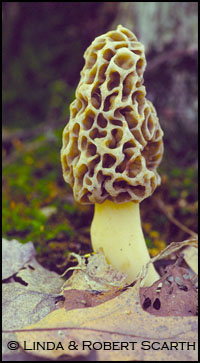introduction - galleries - technique - catalogue - notes - links - contact - blog - deep nature

Morel
?Tasting of the sweet damp woods and of the
rain one inch above the meadow:
It was like feasting upon air.? ~ William Jay Smith, from his poem
?Morels.?
Folklore, myths and fairy tales have many references to the magic of mushrooms. Mushrooms have qualities from edible to non-edible to hallucigenic to deadly toxic. The morel is an edible (when properly cooked) mushroom that enchants thousands of people in temperate zones worldwide because it is delicious. There are several types of morels that are tasty and sought after in North America, though there are always cautions about undercooking them and against serving them with alcohol. Gastrointestinal and other discomforts can occur.
There are approximately twenty-eight morel species in the world of which about six or seven are found in eastern North America: Narrowhead Morel (Morchella angusticeps), Burnsite Morel (M. atrotomentosa), Black Morel (M. conica), Thick-footed Morel (M. crassipes), White Morel (M. deliciosa), Common Morel (M. esculenta), and Half-free Morel (M. semilibera). Some authorities considered the highly desirable White Morel to be an early season form of Common Morel. In the west and into Mexico, the delicious White Morel may be another species based on DNA tests. All Morchella are a type of cup fungi with hollow stems, sponge-like caps with ridges between the pits, and no gills. They vary in color: white, cream, yellow, gray and ?black.?
As DNA analysis on mushrooms has increased, more species are being differentiated while some previously separate species are combined. It is thought that morels evolved from a yeast at the beginning of an ice age about 100,000 years ago to become a resident of moist rich woodlands. Morels thrive in spring weather and conditions. They feed on decaying plant materials and help recycle the forest.
If one finds a somewhat morel-shaped mushroom that is reddish brown, it is probably a False Morel which is very poisonous when eaten raw. False Morels (Gyromitra esculenta), sometimes called Beefsteak or Red Mushrooms, do not have ridges and are brain-like with wavy lobes and solid stems. Photograph but do not eat them is the usual advice; although some people do eat them after careful preparation.
There are several other genus called morels, but the genus Morchella is the one most mushroom hunters follow Pied-Piper-like into the woods. Each spring morel enthusiasts follow their secret round-about paths to the tree where the best ones grow. Morels are often found near fallen elms, in abandoned old orchards, under tulip poplars, near hickory, maple, or ash trees, in recently burned forests, and just about anywhere the conditions are conducive for this fungus to fruit.
Common and White Morels are both actually yellow morels, which are sometimes creamy white or gray. They have a meat-like texture and delicate flavor that encourages cooks to use them in many ways. We like them saut?ed in butter to accompany scrambled eggs. Communities sometimes have morel festivals during the peak morel season ? April through June. The Czech Museum in Cedar Rapids, IA sponsors Houby Days in mid May with prizes for the various Houba categories. Muscoda, WI calls itself the Morel Capitol of Wisconsin and Boyne City, MI sponsors a national morel mushroom hunt in May.
Of course, like most widespread species, morels have local common names in addition to those noted above. ?Dryland fish? is among the most interesting names for morels. They grow near streams in the Appalachians and sometimes have a fishy taste. Morels are also called ?merkels? or ?miracles? because of a story of a family saved from starvation by harvesting them. Sponge Mushrooms and Butter Sponge are other names for the Common Morel.
Just as people gather mushrooms, we gathered the information in this essay from many sources (some contradicting others) and hope the essay we prepared is palatable as a buttery saut?ed morel. This taste may encourage you to go for seconds and search for more information on this magical mushroom.
? Linda & Robert Scarth, 2007.
First published in NatureScape News, 2 (5), 2007.
